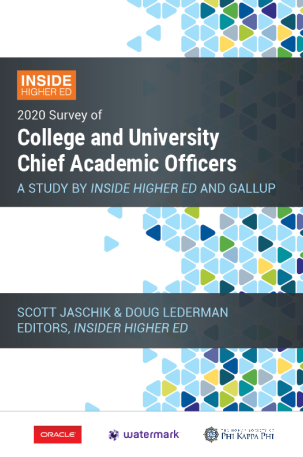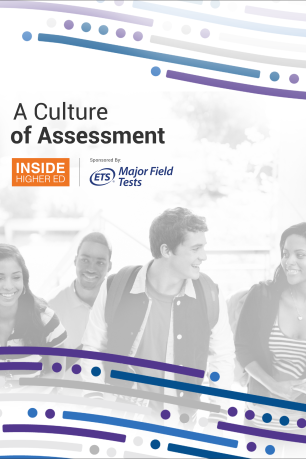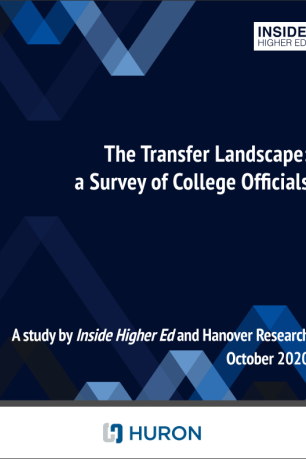Free Download

Only 22 percent of provosts believe their institution is very effective at recruiting and retaining talented faculty members, according to the 2020 Survey of College and University Chief Academic Officers by Inside Higher Ed.
The results are the lowest measured to date in the nine years Inside Higher Ed has conducted this survey, and nearly half of what they were from 2012 to 2014.
The totals come from Inside Higher Ed's annual survey of provosts (or equivalent job title when a college doesn't have a provost). This year, 597 provosts answered at least some of the questions in the survey.
Among the findings:
- Eighty-seven percent of provosts characterize their institution's academic health as "excellent" or "good."
- Nearly all provosts say that that their college is effective in providing a quality undergraduate education, but only 57 percent of the provosts said that their institutions were "very effective." In addition, when asked about elements of providing a quality undergraduate education, many provosts were ambivalent about how their institutions are doing.
About the Survey
Inside Higher Ed’s 2020 Survey of College and University Chief Academic Officers was conducted in conjunction with researchers from Gallup. Inside Higher Ed regularly surveys key higher ed professionals on a range of topics.
On Tuesday, Feb. 25, at 2 p.m. Eastern, Inside Higher Ed will present a free webcast to discuss the results of the survey. Register here for the webcast.
The Inside Higher Ed Survey of College and University Chief Academic Officers was made possible in part with support from Oracle, Watermark, Phi Kappa Phi and Gallup.
- Eighty-one percent of provosts agree or strongly agree that tenure remains important and viable at their institutions. That is a record high figure, but 77 percent of the provosts said that their institution relies significantly on non-tenure-track faculty for instruction -- and they don't see that changing.
- More than eight in 10 provosts believe that the concept of a liberal arts education is not understood in the United States -- even though 87 percent believe that liberal arts education is crucial to undergraduate education.
- Provosts are divided on whether counting the number of students majoring in a field is an appropriate criterion for deciding whether to eliminate a department. Last year, they were more inclined to disagree.
- Three-quarters of provosts are concerned about the trend of shutting down departments, now prevalent in higher education.
- Provosts are much more likely to expect that STEM programs and professional or preprofessional programs will receive major allocation of funds at their institution in the coming year than to think arts and sciences programs will.
- Seventy-two percent of provosts strongly agree or agree that higher education has tolerated sexual harassment by faculty members for too long, but only 15 percent believe the same about their own institution.
- Most provosts favor tough policies to prevent sexual harassment, including barring all faculty-student romantic relationships and dismissing tenured faculty members who have been found guilty of harassment. They overwhelmingly believe their college has clear policies in place to prevent sexual harassment by faculty members and that it responds fairly and effectively to such allegations.
The Institutions' Academic Health
The last year has seen numerous challenges to higher education, especially outside elite higher education. While some institutions continue to thrive, many are in cutback mode. Eliminating programs -- and faculty jobs -- has become common.
Despite those problems, 87 percent of chief academic officers evaluate the academic health of their institution positively, including 29 percent who say it is “excellent” and 58 percent “good.” Academic health ratings have generally been stable over time, with no less than 84 percent assessing their institution positively. In the last two years, however, less than 30 percent have rated their college’s academic health as excellent.
Provosts at public doctoral institutions were most likely to answer "excellent," with 40 percent of them doing so. Those at public bachelor's and master's institutions were the least likely, with only 18 percent.
But as in past years, the provosts were much more likely to give themselves good grades over all than in some of the specifics that make up a quality undergraduate education.
The chief academic officers were also asked to rank their institutions' effectiveness at providing a quality undergraduate education. Fifty-seven percent said they were very effective, and 42 percent said somewhat effective, the first and second figures up one percentage point each in a year.
Percentage of Provosts Who View Their Institutions as ‘Very Effective’ in …
| Category | Public | Private Nonprofit |
| Preparing students for the world of work | 40% | 42% |
| Offering undergraduate support services | 38% | 44% |
| Controlling rising prices for students and their families | 36% | 15% |
| Identifying and assessing student outcomes | 23% | 22% |
| Using data to aid and inform campus decision making | 26% | 18% |
| Recruiting and retaining talented faculty | 17% | 30% |
The figures on recruiting and retaining talented faculty members were the lowest measured to date, especially at public institutions, where only 17 percent of provosts said that they were very effective. The findings come at a time when many colleges are experiencing tough faculty-administrator relations, frequently catching provosts in the middle.
To many faculty members, whether or not they have tenure, it remains something that they value and hope their institutions value.
Provosts definitely believe that tenure remains important and viable at their institutions, with 81 percent agreeing or strongly agreeing. In 2016, only 67 percent of provosts answered the question that way. Nine out of 10 provosts at public institutions (except for community colleges) agreed with the statement.
But 63 percent of chief academic officers say their institution will be “as reliant as it is today on non-tenure-track faculty members” for instruction, while 28 percent say they will be more reliant and 9 percent less so. The percentage of provosts who think their college will be more reliant on non-tenure-track faculty has ticked up slightly since 2014 (when it was 22 percent). Thirty-five percent of private institution academic leaders, compared with 23 percent of those at public institutions, think their college will increase its use of non-tenure-track faculty in the future.
Given the high percentage of adjuncts in higher education, the implication is that tenure may valued, but only for some.
How do professors qualify for tenure? While only a minority of provosts say that faculty members can earn tenure based on research success even if they have ineffective teaching records, 15 percent is the highest percentage ever. Between 2013 and 2018, an average of 8 percent held this view, including 10 percent a year ago. Provosts are in fact more likely to say teaching (82 percent) is more important than research (5 percent) for faculty members; 13 percent say they are equally important. Public doctoral institution provosts are most distinct in their views, with 20 percent saying teaching is more important, 34 percent saying research is more important and 46 percent saying they are equally important.
The provosts were asked about an alternative to tenure: long-term contracts. Sixty-two percent said they are in favor, and 38 percent are opposed. The percentage in favor has typically been above 60 percent but dipped to 56 percent a year ago.
A slim majority of provosts, 51 percent, strongly agree or agree that graduate programs are admitting more Ph.D. students than they should, given the current job market; 21 percent strongly disagree or disagree. Last year, 45 percent strongly agreed or agreed.
Changes in Institutional Practices
In terms of changing institutional policies, the provosts again were consistent with their views in recent years of not proposing radical changes. Low percentages of provosts said that they supported eliminating tenure, cutting athletics or changing institutional missions. Far more would expect to expand online programs.
| Policy | % of Public Institutions | % of Private Institutions |
| Increased collaboration with other colleges | 94% | 90% |
| Funding programs based on alignment with mission | 91% | 83% |
| Expanding online programs | 88% | 84% |
| Cutting underperforming academic programs | 78% | 75% |
| Dismissing underperforming faculty members | 71% | 61% |
| Promoting retirement of older professors | 43% | 65% |
| Increasing use of part-time faculty members | 37% | 40% |
| Dismissing underperforming tenured faculty members | 41% | 29% |
| Using outside providers to expand online programs | 17% | 33% |
| Increasing teaching loads for full-time faculty members | 18% | 24% |
| Altering tenure policies | 20% | 17% |
| Outsourcing some instructional services | 11% | 21% |
| Changing the academic mission of the institution | 8% | 6% |
| Cutting athletics programs | 4% | 9% |
General Education
General education is like many things in this survey -- the provosts express strong philosophical support for the idea but have questions on how it actually plays out.
Ninety-one percent of chief academic officers strongly agree or agree that general education is a crucial part of any college degree. More than six in 10 strongly agree this is the case, with private college provosts more likely than their public college counterparts to agree at that level.
But some provosts agree with critics of general education. By 45 percent to 36 percent, they are more likely to disagree than agree that general education requirements have become too expansive. But provosts at public four-year institutions are more inclined to agree than disagree with that idea.
Provosts also are skeptical that their students understand the purpose of general education. Only a quarter (25 percent) of provosts agree that students understand, while 36 percent disagree and 38 percent are neutral. Private baccalaureate provosts are most likely to agree that their students understand, but only 34 percent hold this view.
On the issue of writing, 43 percent of provosts agree that students emerge from general education with sufficient writing skills. Twenty-two percent disagree. Provosts at private bachelor's colleges were more likely than others to agree, with a majority endorsing the statement.
Most provosts (63 percent) believe that faculty members at their college are enthusiastic about teaching general education courses. But there is a very wide spread on the question, with 76 percent at community colleges and 44 percent at public doctoral institutions.
Painful Cuts
The last year has seen many colleges cut academic departments and programs. Provosts are worried about these cuts, the survey suggests.
Thirty-four percent of public colleges' provosts said they have cut majors or departments. And 41 percent of private colleges' provosts have done so. Seventy-three percent of public college provosts, and 79 percent of private college provosts, said they were somewhat or very concerned about the cuts in higher education generally.
Half of public university provosts (50 percent) were somewhat or very concerned about the cuts at their colleges, and 52 percent of provosts at private colleges were somewhat or very concerned about the cuts at their colleges.
Many provosts defend the liberal arts and see it as necessary to have traditional disciplines and don't like the idea of judging departments based solely on the number of majors.
| Statement | % of Public Provosts Strongly Agree | % of Private Provosts Strongly Agree |
| High-quality undergraduate education requires healthy departments in fields such as English, history, political science and other liberal arts fields. | 58% | 63% |
| Politicians and board members are prioritizing STEM and professional programs over those that support general education. | 37% | 31% |
| The number of students in a program is an appropriate way to determine which departments to cut. | 5% | 6% |
But despite the provosts' support for the traditional liberal arts, only 9 percent of provosts at public institutions and 12 percent at private institutions said that they would increase funding for arts and sciences programs in the next year. The numbers were much higher for STEM programs, preprofessional programs and online programs.
Liberal Arts
The liberal arts are another area that the provosts view as essential, but where they question the ability (or willingness) of institutions to support them.
At public institutions, 83 percent of provosts agree that "a liberal arts education is central to undergraduate education -- even in professional programs." The figure at private institutions is 91 percent.
But both public and private college provosts believe liberal arts education is in decline. Forty-six percent of public university provosts believe so, up from 32 percent the previous year. Among academic officers at private institutions, the share is 55 percent, up from 43 percent.
Additionally, 60 percent of all provosts expect to see the number of liberal arts colleges in the U.S. decline significantly over the next five years, while just 9 percent disagree that will happen. The percentage predicting a decline is up slightly from 55 percent a year ago.
Perhaps explaining this, 82 percent of public institution provosts and 86 percent of private college provosts said that "the concept of a liberal arts education is not well understood in the U.S."
Assessment
As the chief academic officers of their institutions, provosts are key players in assessment efforts.
Asked if their institution makes effective use of data used to measure student outcomes, nearly three-quarters (73 percent) answered in the affirmative.
Provosts also believe that assessment works. By 46 percent to 19 percent, provosts agree rather than disagree that the growth of assessment systems has improved the quality of teaching and learning at their college.
A slim majority of chief academic officers, 51 percent, say their college regularly makes changes to curriculum, teaching practices or student services based on what it finds through assessment. Eighteen percent disagree that this is the case. In contrast, only 34 percent of faculty members said this in Inside Higher Ed's survey of them.
Sexual Harassment
On the issue of sexual harassment, which has attracted considerably more attention in the era of Me Too, provosts agree that higher education has tolerated sexual harassment for too long. Seventy percent of public provosts said that was the case, and 75 percent of private provosts.
But asked if their institution has tolerated sexual harassment for too long, only 15 percent of provosts at public institutions and 16 percent at private institutions agreed.
As for specifics, the provosts were asked if a finding of harassment by a tenured faculty member should be grounds for dismissal, and 89 percent of provosts agreed.
The provosts were also asked if colleges should ban any romantic relationship between faculty members and students. At public institutions, 73 percent of provosts agreed. At private institutions, 87 percent of provosts did.
But asked if their institution does so, only 53 percent of provosts at public institutions, and 79 percent of those at private institutions, said they did.
Competency
Support for competency-based education continue to grow, but more so at public institutions than at private ones. At public institutions, 88 percent of provosts believe that academic credit should be awarded on demonstrated competence in the field, not on seat time. And 64 percent of provosts at private institutions agree. The highest level of support is at community colleges, where 90 percent of provosts back a competency-based approach.
Sixty-five percent of public provosts said their institution awarded credit based on demonstrated competence, but only 33 percent of those at private institutions do.
Of institutions that currently don't award the credit, nearly half (49 percent) said they are currently exploring a competency-based program. Only 21 percent of private provosts said they were exploring.



